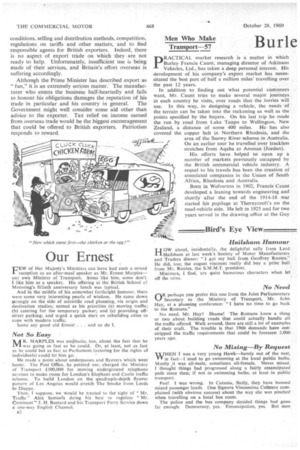Burle rancis Caunt
Page 36

Page 37

If you've noticed an error in this article please click here to report it so we can fix it.
pRACTICAL market research is a matter in which Burley Francis Caunt, managing director of Atkinson Vehicles, Ltd., has taken a deep personal interest. His development of his company's export market has necessitated the best part of half a million miles' travelling over the past 12 years.
In addition to finding out what potential customers want, Mr. Caunt tries to make several major journeys in each country he visits, over roads that the lorries will use. In this way, in designing a vehicle, the needs of the terrain can be taken into the reckoning as well as the points specified by the buyers. On his last trip he made the run by road from Lake Taupo to Wellington, New Zealand, a distance of some 400 miles. He has also covered the copper belt in Northern Rhodesia, and the area of the Snowy River scheme in Australia. On an earlier tour he travelled over trackless stretches from Aqaba to Amman (Jordan).
His efforts have helped to open up a number of markets previously untapped by the British commercial vehicle industry. A sequel to his travels has been the creation of associated companies in the Union of South Africa, Rhodesia and Australia.
Born in Wolverton in 1902, Francis Caunt developed a leaning towards engineering and shortly after the end of the 1914-18 war started his pupilage at Thornycroft's on the road-vehicle side. He left in 1925 and for two years served in the drawing office at the Guy factory. Two years later he became confidential designer to the chief engineer at the Karrier works, then at Huddersfield. This move brought Mr. Caunt his first real opportunity to initiate design features and at this stage he took part in the evolution of the Karrier Ro-Railer. [After an interval of about 30 years the road-rail vehicle has returned, although in a rather different farm from that pioneered by Karrier.] The Cob—a very different kettle of fish—followed.
An opening as a senior designer attracted Mr. Caunt to Leyland in 1930, where he was later appointed chief draughtsman, with responsibility for all the production design for the complete Leyland range, including trolleybuses. A hankering after the practical side was fulfilled in 1940 when he became assistant works manager on tank production at Farington and Charley. In this sphere he supervised, in addition, the maintenance of spare parts and service to Leyland vehicles throughout the rest of the war.
In the period of turmoil that accompanied peace, he acted as works manager for an engineering concern at Leamington, returning to the industry as general manager of the Atkinson organization in 1946. At that time he was understudying Mr. H. B. Fielding, managing director, whom he succeeded in mid-1949.
When he joined them, Atkinson's were located in the small factory in Marsh Lane, Preston, and a single building housed the production and service departments. The move to the present extensive site at Walton-le-Dale, in 1947, necessitated an appraisal of the production situation. Mr. Caunt settled for a " finished-to-measure " policy. This is what Atkinson's (forgive them) have come to call " rangeability."
From 1948 onwards it was the new managing director's self-appointed task to examine the export situation and to find the basic requirements of vehicles that might have to serve the needs of South Africa, Australia, New Zealand, Portugal, Spain and many other countries. The minimum requirement in travel was one major overseas tour each year and it is fair to say that this programme culminated in the development of the largest vehicle exhibited at Earls Court in 1958—the Omega for Saudi Arabia.
_ Optimistic About Africa
Many Atkinsons are still being sent to South Africa and, although Mr. Caunt has seen the South African market fluctuate, he is convinced that the good days of this continent will return. Whilst the political situation is having Its effect on business there, he is certain that this period will be followed by one of readjustment. -He visualizes a vast trade expansion in Australia as a result of the growing industrial development, subject, of course, to the maintenance of the necessary level of immigration: At the same time, he feels -that the present encouraging signs should not blind British industrialists to the fact that the Japanese, and, of course, the Germans, are entering the Australian market with vehicles of promising design.
When work is done, Mr. Caunt turns to his hobby--the study of commercial vehicles. Running parallel with his travels throughout the world is an interest in philately. As a schoolboy he was. an enthusiastic stamp collector,.a • study which was given a new lease of •life during his daughters' schooldays. Travelling has enabled him to -acquire many an interesting specimen.
And if there are still minutes to spare, the naturalized northerner from the Home Counties can well occupy them. in his garden at the Lancashire resort of St. .Annes-on the-Sea. A.T.




















































































































